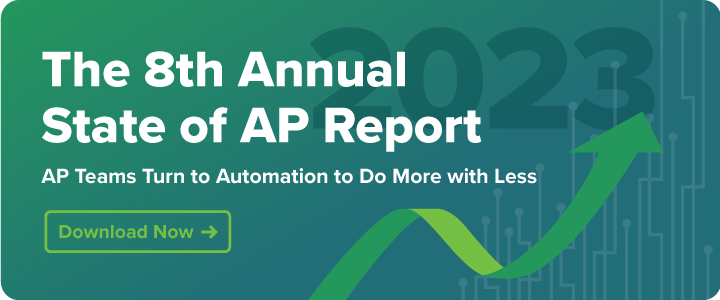Maintaining finance department efficiency is a constant challenge, especially for teams that rely on legacy technology and manual processes. The good news is that technological advancements have made it possible for finance departments to increase productivity and to do more with less.
As the need to drive efficiency grows, many teams are looking to technology to digitize and automate their workflows. The right AP automation solutions can help finance departments not only eliminate tedious, manual work but also streamline their processes and stay compliant with evolving regulations.

What are the Challenges in Finance?
Finance departments have encountered their fair share of obstacles in an uncertain economy. Let’s take a closer look at some of the challenges that are driving the need for greater productivity:
The Ability to Hire Qualified Staff
Finding and retaining qualified finance professionals can be a challenge as demand for specialized skills grows. This has been a major hurdle for finance departments in 2023 because many employees have switched jobs and careers due to the Great Resignation. Even if an organization does find first-rate talent, budgetary concerns often stand in the way.
Inflation
Inflation and interest rates skyrocketed in 2023, placing additional pressure on finance departments to expand efficiency across their operations. In fact, Deloitte noted that inflation is one of the biggest challenges being faced by CFOs, with 62% of those surveyed agreeing that it is not a good time for companies to take risks. Inflation can significantly impact an organization’s financial health, affecting income and expenses.
Doing More With Less
Finance departments often have to maintain or improve their performance when facing budget constraints and pressure to reduce costs. With hiring freezes and budget cuts in play, it’s natural that 59% of finance leaders say doing more with less is a top issue for accounts payable (AP) teams in the current economic climate.
8 Ways to Improve Efficiency in Finance Departments
Boosting efficiency remains a key priority for finance departments navigating recent talent challenges and financial constraints. So, how can you improve finance department productivity when resources are tight? Here are eight steps to keep operations running smoothly at all times:
1. Embrace Digitization
Digitization is a transformative force that’s reshaping the finance industry. But while the majority of finance leaders agree that digital transformation is disrupting the industry, many are unsure where to start. A lack of specialized talent and the influx of innovative technologies we’ve seen in recent years doesn’t make tackling a digital transformation any easier.
The good news is that digitization doesn’t have to happen overnight. Consider the areas of your finance operations that would drive the most value if digitized. According to MineralTree’s 2023 State of AP Report, AP ranked as the top digitization priority for the third year in a row. AP automation offers various benefits, like increased visibility into cash flow, making it a great place to start your digitization efforts.
2. Reduce Human Error
Human errors like duplicate payments or late payments can be costly and time-consuming to rectify. Consider using automated solutions that streamline invoice approvals and eliminate the potential for human error. Many of these solutions also centralize invoice collection and enhance payment processing workflows. Implementing best practices like cross-referencing invoices against payment records can also help minimize errors.
3. Ensure Data Accuracy
Data accuracy is vital for all aspects of finance, from budgeting to reporting. Accurate data reduces the likelihood of costly errors and ensures your financial decisions are based on reliable information. As a result, you ensure better cash flow forecasting and improved month-end close, auditing, and compliance.
4. Invest in Better Reporting Tools
Enhancing your reporting capabilities is crucial for better decision-making and streamlined financial processes. Reporting tools provide you with real-time insights so you can identify areas for improvement and make data-driven decisions. These tools also empower you to proactively address financial challenges and optimize resource allocation for more effective and agile financial management.
5. Make It Easier to Approve Invoices
Efficient invoice approval workflows are essential for preventing bottlenecks and simplifying financial operations. Leveraging customized processes and solutions like MineralTree allows you to route invoices to the appropriate stakeholders for review, ensuring smooth monitoring and tracking. This expedites the approval cycle, guaranteeing invoices are processed in a timely fashion.
6. Mitigate Security Risks
Mitigating financial security risks is paramount in safeguarding your organization’s financial well-being. To combat invoice fraud, it’s crucial to implement stringent fraud detection mechanisms and educate employees about potential scams. Identifying vendor fraud necessitates a proactive approach involving thorough due diligence and regular monitoring of relationships.
Business Email Compromise (BEC) scams are another common security risk for AP teams. Understanding which employees are most often targeted by BEC attacks can help you deliver customized cybersecurity awareness training to ensure employees at all levels are equipped to recognize and thwart BEC attacks.
7. Invest in Paperless Processes
Transitioning to a paperless AP process minimizes manual paperwork requirements and expedites document retrieval and approval cycles. Moreover, it diminishes the likelihood of errors linked to traditional paper-based systems. Shifting to paperless procedures leads to cost savings and enhances productivity, affording you more time and resources to dedicate to value-added tasks.
8. Automate the Entire End-to-End AP Process
AP automation technology encompasses invoice capture, approval workflows, payment processing, and reconciliation. Automating these tasks reduces manual data entry, minimizes the risk of errors, and accelerates the entire AP cycle. This results in cost savings and enables you to redirect your focus toward strategic financial analysis and decision-making — and away from routine administrative tasks.
Final Thoughts
Improving workflows across the finance department is critical in achieving cost savings, meeting financial objectives, and ensuring your organization can adapt and thrive in an ever-evolving business environment. Investing in the right tools and embracing digitization and AP automation can boost efficiency and enhance your overall financial performance.
Get in touch to learn how MineralTree can help you streamline your financial operations, while improving efficiency in your accounts payable department.

Frequently Asked Questions
What Makes a Successful Finance Department?
A successful finance department combines skilled professionals, streamlined processes, advanced technology, and a commitment to accuracy, compliance, and efficiency. Success is measured by the department’s ability to contribute to the organization’s overall financial health and strategic objectives.
How Can You Add Value to the Finance Department?
Adding value to the finance department involves optimizing processes, reducing costs, improving accuracy, enhancing reporting and analytics, and leveraging technology to support strategic decision-making. It also requires fostering a culture of continuous improvement and cross-functional collaboration, where each team member is encouraged to contribute their expertise to drive the department’s overall success.



